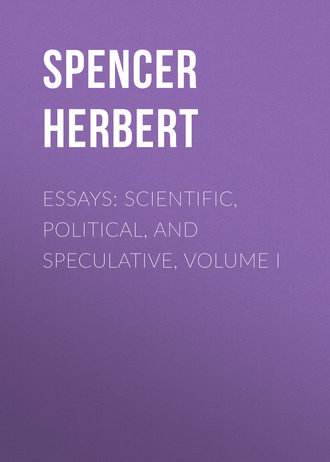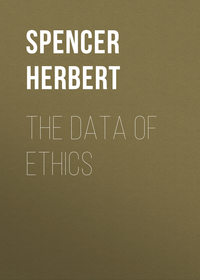 полная версия
полная версияEssays: Scientific, Political, and Speculative, Volume I
And now let us return to the visible characters of nebulæ, as observed through modern telescopes. Take first the description of those nebulæ which, by the hypothesis, must be in an early stage of evolution.
Among the "irregular nebulæ," says Sir John Herschel, "may be comprehended all which, to a want of complete and in most instances even of partial resolvability by the power of the 20-feet reflector, unite such a deviation from the circular or elliptic form, or such a want of symmetry (with that form) as preclude their being placed in class 1, or that of Regular Nebulæ. This second class comprises many of the most remarkable and interesting objects in the heavens, as well as the most extensive in respect of the area they occupy."
And, referring to this same order of objects, M. Arago says: – "The forms of very large diffuse nebulæ do not appear to admit of definition; they have no regular outline."
This coexistence of largeness, irregularity, and indefiniteness of outline, with irresolvability, is extremely significant. The fact that the largest nebulæ are either irresolvable or very difficult to resolve, might have been inferred a priori; seeing that irresolvability, implying that the aggregation of precipitated matter has gone on to but a small extent, will be found in nebulæ of wide diffusion. Again, the irregularity of these large, irresolvable nebulæ, might also have been expected; seeing that their outlines, compared by Arago with "the fantastic figures which characterize clouds carried away and tossed about by violent and often contrary winds," are similarly characteristic of a mass not yet gathered together by the mutual attraction of its parts. And once more, the fact that these large, irregular, irresolvable nebulæ have indefinite outlines – outlines that fade off insensibly into surrounding darkness – is one of like meaning.
Speaking generally (and of course differences of distance negative anything beyond average statements), the spiral nebulæ are smaller than the irregular nebulæ, and more resolvable; at the same time that they are not so small as the regular nebulæ, and not so resolvable. This is as, according to the hypothesis, it should be. The degree of condensation causing spiral movement, is a degree of condensation also implying masses of flocculi that are larger, and therefore more visible, than those existing in an earlier stage. Moreover, the forms of these spiral nebulæ are quite in harmony with the explanation given. The curves of luminous matter which they exhibit, are not such as would be described by discrete masses starting from a state of rest, and moving through a resisting medium to a common centre of gravity; but they are such as would be described by masses having their movements modified by the rotation of the medium.
In the centre of a spiral nebula is seen a mass both more luminous and more resolvable than the rest. Assume that, in process of time, all the spiral streaks of luminous matter which converge to this centre are drawn into it, as they must be; assume further, that the flocculi, or other discrete portions constituting these luminous streaks, aggregate into larger masses at the same time that they approach the central group, and that the masses forming this central group also aggregate into larger masses; and there will finally result a cluster of such larger masses, which will be resolvable with comparative ease. And, as the coalescence and concentration go on, the constituent masses will gradually become fewer, larger, brighter, and more densely collected around the common centre of gravity. See now how completely this inference agrees with observation. "The circular form is that which most commonly characterises resolvable nebulæ," writes Arago. Resolvable nebulæ, says Sir John Herschel, "are almost universally round or oval." Moreover, the centre of each group habitually displays a closer clustering of the constituent masses than the outer parts; and it is shown that, under the law of gravitation, which we now know extends to the stars, this distribution is not one of equilibrium, but implies progressing concentration. While, just as we inferred that, according to circumstances, the extent to which aggregation has been carried must vary; so we find that, in fact, there are regular nebulæ of all degrees of resolvability, from those consisting of innumerable minute masses, to those in which their numbers are smaller and the sizes greater, and to those in which there are a few large bodies worthy to be called stars.
On the one hand, then, we see that the notion, of late years uncritically received, that the nebulæ are extremely remote galaxies of stars like those which make up our own Milky Way, is totally irreconcilable with the facts – involves us in sundry absurdities. On the other hand, we see that the hypothesis of nebular condensation harmonizes with the most recent results of stellar astronomy: nay more – that it supplies us with an explanation of various appearances which in its absence would be incomprehensible.
Descending now to the Solar System, let us consider first a class of phenomena in some sort transitional – those offered by comets. In them, or at least in those most numerous of them which lie far out of the plane of the Solar System, and are not to be counted among its members, we have, still existing, a kind of matter like that out of which, according to the Nebular Hypothesis, the Solar System was evolved. Hence, for the explanation of them, we must go back to the time when the substances forming the sun and planets were yet unconcentrated.
When diffused matter, precipitated from a rarer medium, is aggregating, there are certain to be here and there produced small flocculi, which long remain detached; as do, for instance, minute shreds of cloud in a summer sky. In a concentrating nebula these will, in the majority of cases, eventually coalesce with the larger flocculi near to them. But it is tolerably evident that some of those formed at the outermost parts of the nebula, will not coalesce with the larger internal masses, but will slowly follow without overtaking them. The relatively greater resistance of the medium necessitates this. As a single feather falling to the ground will be rapidly left behind by a pillow-full of feathers; so, in their progress to the common centre of gravity, will the outermost shreds of vapour be left behind by the great masses of vapour internally situated. But we are not dependent merely on reasoning for this belief. Observation shows us that the less concentrated external parts of nebulæ, are left behind by the more concentrated internal parts. Examined through high powers, all nebulæ, even when they have assumed regular forms, are seen to be surrounded by luminous streaks, of which the directions show that they are being drawn into the general mass. Still higher powers bring into view still smaller, fainter, and more widely-dispersed streaks. And it cannot be doubted that the minute fragments which no telescopic aid makes visible, are yet more numerous and widely dispersed. Thus far, then, inference and observation are at one.
Granting that the great majority of these outlying portions of nebulous matter will be drawn into the central mass long before it reaches a definite form, the presumption is that some of the very small, far-removed portions will not be so; but that before they arrive near it, the central mass will have contracted into a comparatively moderate bulk. What now will be the characters of these late-arriving portions?
In the first place, they will have either extremely eccentric orbits or non-elliptic paths. Left behind at a time when they were moving towards the centre of gravity in slightly-deflected lines, and therefore having but very small angular velocities, they will approach the central mass in greatly elongated curves; and rushing round it, will go off again into space. That is, they will behave just as we see the majority of comets do; the orbits of which are either so eccentric as to be indistinguishable from parabolas, or else are not orbits at all, but are paths which are distinctly either parabolic or hyperbolic.
In the second place, they will come from all parts of the heavens. Our supposition implies that they were left behind at a time when the nebulous mass was of irregular shape, and had not acquired a definite rotation; and as the separation of them would not be from any one surface of the nebulous mass more than another, the conclusion must be that they will come to the central body from various directions in space. This, too, is exactly what happens. Unlike planets, whose orbits approximate to one plane, comets have orbits that show no relation to one another; but cut the plane of the ecliptic at all angles, and have axes inclined to it at all angles.
In the third place, these remotest flocculi of nebulous matter will, at the outset, be deflected from their direct courses to the common centre of gravity, not all on one side, but each on such side as its form, or its original proper motion, determines. And being left behind before the rotation of the nebula is set up, they will severally retain their different individual motions. Hence, following the concentrated mass, they will eventually go round it on all sides; and as often from right to left as from left to right. Here again the inference perfectly corresponds with the facts. While all the planets go round the sun from west to east, comets as often go round the sun from east to west as from west to east. Of 262 comets recorded since 1680, 130 are direct, and 132 are retrograde. This equality is what the law of probabilities would indicate.
Then, in the fourth place, the physical constitution of comets accords with the hypothesis.15 The ability of nebulous matter to concentrate into a concrete form, depends on its mass. To bring its ultimate atoms into that proximity requisite for chemical union – requisite, that is, for the production of denser matter – their repulsion must be overcome. The only force antagonistic to their repulsion, is their mutual gravitation. That their mutual gravitation may generate a pressure and temperature of sufficient intensity, there must be an enormous accumulation of them; and even then the approximation can slowly go on only as fast as the evolved heat escapes. But where the quantity of atoms is small, and therefore the force of mutual gravitation small, there will be nothing to coerce the atoms into union. Whence we infer that these detached fragments of nebulous matter will continue in their original state. Non-periodic comets seem to do so.
We have already seen that this view of the origin of comets harmonizes with the characters of their orbits; but the evidence hence derived is much stronger than was indicated. The great majority of cometary orbits are classed as parabolic; and it is ordinarily inferred that they are visitors from remote space, and will never return. But are they rightly classed as parabolic? Observations on a comet moving in an extremely eccentric ellipse, which are possible only when it is comparatively near perihelion, must fail to distinguish its orbit from a parabola. Evidently, then, it is not safe to class it as a parabola because of inability to detect the elements of an ellipse. But if extreme eccentricity of an orbit necessitates such inability, it seems quite possible that comets have no other orbits than elliptic ones. Though five or six are said to be hyperbolic, yet, as I learn from one who has paid special attention to comets, "no such orbit has, I believe, been computed for a well-observed comet." Hence the probability that all the orbits are ellipses is overwhelming. Ellipses and hyperbolas have countless varieties of forms, but there is only one form of parabola; or, to speak literally, all parabolas are similar, while there are infinitely numerous dissimilar ellipses and dissimilar hyperbolas. Consequently, anything coming to the Sun from a great distance must have one exact amount of proper motion to produce a parabola: all other amounts would give hyperbolas or ellipses. And if there are no hyperbolic orbits, then it is infinity to one that all the orbits are elliptical. This is just what they would be if comets had the genesis above supposed.
And now, leaving these erratic bodies, let us turn to the more familiar and important members of the Solar System. It was the remarkable harmony among their movements which first made Laplace conceive that the Sun, planets, and satellites had resulted from a common genetic process. As Sir William Herschel, by his observations on the nebulæ, was led to the conclusion that stars resulted from the aggregation of diffused matter; so Laplace, by his observations on the structure of the Solar System, was led to the conclusion that only by the rotation of aggregating matter were its peculiarities to be explained. In his Exposition du Système du Monde, he enumerates as the leading evidences: – 1. The movements of the planets in the same direction and in orbits approaching to the same plane; 2. The movements of the satellites in the same direction as those of the planets; 3. The movements of rotation of these various bodies and of the sun in the same direction as the orbital motions, and mostly in planes little different; 4. The small eccentricities of the orbits of the planets and satellites, as contrasted with the great eccentricities of the cometary orbits. And the probability that these harmonious movements had a common cause, he calculates as two hundred thousand billions to one.
This immense preponderance of probability does not point to a common cause under the form ordinarily conceived – an Invisible Power working after the method of "a Great Artificer;" but to an Invisible Power working after the method of evolution. For though the supporters of the common hypothesis may argue that it was necessary for the sake of stability that the planets should go round the Sun in the same direction and nearly in one plane, they cannot thus account for the direction of the axial motions.16 The mechanical equilibrium would not have been interfered with, had the Sun been without any rotatory movement; or had he revolved on his axis in a direction opposite to that in which the planets go round him; or in a direction at right angles to the average plane of their orbits. With equal safety the motion of the Moon round the Earth might have been the reverse of the Earth's motion round its axis; or the motions of Jupiter's satellites might similarly have been at variance with his axial motion; or those of Saturn's satellites with his. As, however, none of these alternatives have been followed, the uniformity must be considered, in this case as in all others, evidence of subordination to some general law – implies what we call natural causation, as distinguished from arbitrary arrangement.
Hence the hypothesis of evolution would be the only probable one, even in the absence of any clue to the particular mode of evolution. But when we have, propounded by a mathematician of the highest authority, a theory of this evolution based on established mechanical principles, which accounts for these various peculiarities, as well as for many minor ones, the conclusion that the Solar System was evolved becomes almost irresistible.
The general nature of Laplace's theory scarcely needs stating. Books of popular astronomy have familiarized most readers with his conceptions; – namely, that the matter now condensed into the Solar System, once formed a vast rotating spheroid of extreme rarity extending beyond the orbit of the outermost planet; that as this spheroid contracted, its rate of rotation necessarily increased; that by augmenting centrifugal force its equatorial zone was from time to time prevented from following any further the concentrating mass, and so remained behind as a revolving ring; that each of the revolving rings thus periodically detached, eventually became ruptured at its weakest point, and, contracting on itself, gradually aggregated into a rotating mass; that this, like the parent mass, increased in rapidity of rotation as it decreased in size, and, where the centrifugal force was sufficient, similarly left behind rings, which finally collapsed into rotating spheroids; and that thus, out of these primary and secondary rings, there arose planets and their satellites, while from the central mass there resulted the Sun. Moreover, it is tolerably well known that this a priori reasoning harmonizes with the results of experiment. Dr. Plateau has shown that when a mass of fluid is, as far may be, protected from the action of external forces, it will, if made to rotate with adequate velocity, form detached rings; and that these rings will break up into spheroids which turn on their axes in the same direction with the central mass. Thus, given the original nebula, which, acquiring a vortical motion in the way indicated, has at length concentrated into a vast spheroid of aeriform matter moving round its axis – given this, and mechanical principles explain the rest. The genesis of a Solar System displaying movements like those observed, may be predicted; and the reasoning on which the prediction is based is countenanced by experiment.17
But now let us inquire whether, besides these most conspicuous structural and dynamic peculiarities of the Solar System, sundry minor ones are not similarly explicable.
Take first the relation between the planes of the planetary orbits and the plane of the Sun's equator. If, when the nebulous spheroid extended beyond the orbit of Neptune, all parts of it had been revolving exactly in the same plane, or rather in parallel planes – if all its parts had had one axis; then the planes of the successive rings would have been coincident with each other and with that of the Sun's rotation. But it needs only to go back to the earlier stages of concentration, to see that there could exist no such complete uniformity of motion. The flocculi, already described as precipitated from an irregular and widely-diffused nebula, and as starting from all points to their common centre of gravity, must move not in one plane but in innumerable planes, cutting each other at all angles. The gradual establishment of a vortical motion such as we at present see indicated in the spiral nebulæ, is the gradual approach towards motion in one plane. But this plane can but slowly become decided. Flocculi not moving in this plane, but entering into the aggregation at various inclinations, will tend to perform their revolutions round its centre in their own planes; and only in course of time will their motions be partly destroyed by conflicting ones, and partly resolved into the general motion. Especially will the outermost portions of the rotating mass retain for a long time their more or less independent directions. Hence the probabilities are, that the planes of the rings first detached will differ considerably from the average plane of the mass; while the planes of those detached latest will differ from it less.
Here, again, inference to a considerable extent agrees with observation. Though the progression is irregular, yet, on the average, the inclinations decrease on approaching the Sun; and this is all we can expect. For as the portions of the nebulous spheroid must have arrived with miscellaneous inclinations, its strata must have had planes of rotation diverging from the average plane in degrees not always proportionate to their distances from the centre.
Consider next the movements of the planets on their axes. Laplace alleged as one among other evidences of a common genetic cause, that the planets rotate in a direction the same as that in which they go round the Sun, and on axes approximately perpendicular to their orbits. Since he wrote, an exception to this general rule has been discovered in the case of Uranus, and another still more recently in the case of Neptune – judging, at least, from the motions of their respective satellites. This anomaly has been thought to throw considerable doubt on his speculation; and at first sight it does so. But a little reflection shows that the anomaly is not inexplicable, and that Laplace simply went too far in putting down as a certain result of nebular genesis, what is, in some instances, only a probable result. The cause he pointed out as determining the direction of rotation, is the greater absolute velocity of the outer part of the detached ring. But there are conditions under which this difference of velocity may be too insignificant, even if it exists. If a mass of nebulous matter approaching spirally to the central spheroid, and eventually joining it tangentially, is made up of parts having the same absolute velocities; then, after joining the equatorial periphery of the spheroid and being made to rotate with it, the angular velocity of its outer parts will be smaller than the angular velocity of its inner parts. Hence, if, when the angular velocities of the outer and inner parts of a detached ring are the same, there results a tendency to rotation in the same direction with the orbital motion, it may be inferred that when the outer parts of the ring have a smaller angular velocity than the inner parts, a tendency to retrograde rotation will be the consequence.
Again, the sectional form of the ring is a circumstance of moment; and this form must have differed more or less in every case. To make this clear, some illustration will be necessary. Suppose we take an orange, and, assuming the marks of the stalk and the calyx to represent the poles, cut off round the line of the equator a strip of peel. This strip of peel, if placed on the table with its ends meeting, will make a ring shaped like the hoop of a barrel – a ring of which the thickness in the line of its diameter is very small, but of which the width in a direction perpendicular to its diameter is considerable. Suppose, now, that in place of an orange, which is a spheroid of very slight oblateness, we take a spheroid of very great oblateness, shaped somewhat like a lens of small convexity. If from the edge or equator of this lens-shaped spheroid, a ring of moderate size were cut off, it would be unlike the previous ring in this respect, that its greatest thickness would be in the line of its diameter, and not in a line at right angles to its diameter: it would be a ring shaped somewhat like a quoit, only far more slender. That is to say, according to the oblateness of a rotating spheroid, the detached ring may be either a hoop-shaped ring or a quoit-shaped ring.
One further implication must be noted. In a much-flattened or lens-shaped spheroid, the form of the ring will vary with its bulk. A very slender ring, taking off just the equatorial surface, will be hoop-shaped; while a tolerably massive ring, trenching appreciably on the diameter of the spheroid, will be quoit-shaped. Thus, then, according to the oblateness of the spheroid and the bulkiness of the detached ring, will the greatest thickness of that ring be in the direction of its plane, or in a direction perpendicular to its plane. But this circumstance must greatly affect the rotation of the resulting planet. In a decidedly hoop-shaped nebulous ring, the differences of velocity between the inner and outer surfaces will be small; and such a ring, aggregating into a mass of which the greatest diameter is at right angles to the plane of the orbit, will almost certainly give to this mass a predominant tendency to rotate in a direction at right angles to the plane of the orbit. Where the ring is but little hoop-shaped, and the difference between the inner and outer velocities greater, as it must be, the opposing tendencies – one to produce rotation in the plane of the orbit, and the other, rotation perpendicular to it – will both be influential; and an intermediate plane of rotation will be taken up. While, if the nebulous ring is decidedly quoit-shaped, and therefore aggregates into a mass whose greatest dimension lies in the plane of the orbit, both tendencies will conspire to produce rotation in that plane.
On referring to the facts, we find them, as far as can be judged, in harmony with this view. Considering the enormous circumference of Uranus's orbit, and his comparatively small mass, we may conclude that the ring from which he resulted was a comparatively slender, and therefore a hoop-shaped one: especially as the nebulous mass must have been at that time less oblate than afterwards. Hence, a plane of rotation nearly perpendicular to his orbit, and a direction of rotation having no reference to his orbital movement. Saturn has a mass seven times as great, and an orbit of less than half the diameter; whence it follows that his genetic ring, having less than half the circumference, and less than half the vertical thickness (the spheroid being then certainly as oblate, and indeed more oblate), must have had a much greater width – must have been less hoop-shaped, and more approaching to the quoit-shaped: notwithstanding difference of density, it must have been at least two or three times as broad in the line of its plane. Consequently, Saturn has a rotatory movement in the same direction as the movement of translation, and in a plane differing from it by thirty degrees only. In the case of Jupiter, again, whose mass is three and a half times that of Saturn, and whose orbit is little more than half the size, the genetic ring must, for the like reasons, have been still broader – decidedly quoit-shaped, we may say; and there hence resulted a planet whose plane of rotation differs from that of his orbit by scarcely more than three degrees. Once more, considering the comparative insignificance of Mars, Earth, Venus, and Mercury, it follows that, the diminishing circumferences of the rings not sufficing to account for the smallness of the resulting masses, the rings must have been slender ones – must have again approximated to the hoop-shaped; and thus it happens that the planes of rotation again diverge more or less widely from those of the orbits. Taking into account the increasing oblateness of the original spheroid in the successive stages of its concentration, and the different proportions of the detached rings, it may fairly be held that the respective rotatory motions are not at variance with the hypothesis but contrariwise tend to confirm it.









